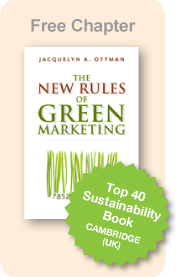Jacquie Ottman's
Green Marketing Blog
Why Eco-Innovation is the Best Response to Greenwashing
June 23, 2011 by Jacquelyn Ottman
As the kickoff speaker to the Sustainable Brands ‘11 conference in Monterey last week, I took it upon myself to lower the boom on greenwash. Rather than trying to parse out the “sins” among us, I encouraged the several hundred participants to focus on what I believe are much larger problems, among them: better products, and an industry that’s ready, willing and able to self-regulate.
Yes, mystifying claims certainly threaten the legitimacy of sustainable business. Exaggerating the evils of greenwashing, however, may gradually discredit the entire green market as a whole. Insisting that greenwashing is more intentional than accidental will increase distrust among consumers and make companies hesitant to tout legitimate green achievements.
No such thing as a green product
In reality, most greenwashing is a natural, inadvertent byproduct of greening. Backlash against such promotions can be expected considering that no product is 100% green. That’s right—there are no green products. As I discuss in my new book, The New Rules of Green Marketing, every product must use resources and create waste. Greener products, however, make authentic communications possible. So, our real problem is not greenwashing. We will usher in more accurate communications when we invent genuinely better products—products that can sell themselves without the use of clichéd images and faulty green claims.
Ideally, we need marketers who strive for eco-innovation. Eco-innovation—sometimes referred to as functional innovation—means innovating at the concept stage. It means developing products and services that meet the same consumer needs as products we are used to, but in entirely new ways. (Think Apple iPod versus stacks of CDs and jewel cases—remember jewel cases??)
Five Avenues of Eco-Innovation
My book identifies the five major avenues of eco-innovation as 1) Innovate at the system level, 2) Develop new materials, 3) Develop new technologies, 4) Develop new business models, and 5) Restore the environment.
Companies that merely shave off waste from existing products and existing production methods are not part of the green vanguard. Rather, the companies using new materials and processes to set industry precedents become the applauded leaders. When sustainability is embedded into ongoing product innovation, a company earns solid credibility.
Time to Self-Regulate
With products on a sustainable footing, we need to assume our roles as self-regulators. We must become knowledgeable about consumer concerns, environmental science and the technical subtleties of greening one’s processes. We must work closely with technical and legal experts to create communications that are in step with FTC Green Guides. Just like our counterparts on Madison Avenue learned to do over the past forty years, we need to start taking questionable claims to the National Advertising Division of the Better Business Bureau—affordably, quickly and out of court.
As self-regulators, we can promote new standards for green advertising that prompt change rather than complacency. We can even take the next step and establish more comprehensive industry labels and certifications for green products. Given our current regulations and certifications, greening simply cannot be clear-cut.
Our greatest challenge, then, is not greenwashing itself. We will reduce greenwashing only when we step up to the innovation plate, creating products that sell themselves, and when we acknowledge our roles as self-regulators, helping to shape a more progressive, mature eco-system for green marketing and sustainable branding overall.



 ShareThis
ShareThis

